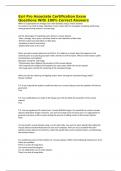Examen
Esri Pro Associate Certification Exam Questions With 100% Correct Answers
- Cours
- Établissement
Esri Pro Associate Certification Exam Questions With 100% Correct Answers When is it appropriate to manage your raster datasets using a mosaic dataset? You want to use small to large collections of your raster data for managing, visualizing, performing many geoprocessing analyses, and querying. ...
[Montrer plus]



